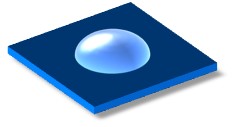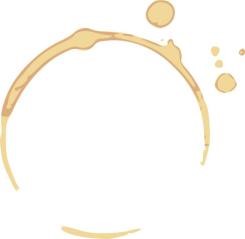When a droplet of coffee dries up on a plate, the nonvolatile solute left on the substrate can form various patterns, such as coffee-ring, volcano-like, mountain-like and multi-ring. This daily life phenomenon is very interesting, and has a wide range of applications like inkjet printing and reducing raindrops remaining on the windshield, yet a full understanding about how to control the deposition patterns is still missing. Now Dr. Man Xingkun and Prof. Masao Doi from the School of Physics and Nuclear Engineering and the Center of Soft Matter Physics and its Applications of Beihang University have proposed a simple theory that describes the droplet shape evolution and predicts the deposit distribution of nonvolatile components on the substrate. With the same theory, they show that the droplet motion can be induced even in the absence of the Marangoni effect due to the gradient of evaporation rate, which is a new mechanism of droplet motion published recently in Physical Review Letters entitled Vapor-Induced Motion of Liquid Droplets on an Inert Substrate.


A diagram of an evaporating droplet and coffee stains
In this paper, Dr. Man and Prof. Doi explained how the droplet motion can be induced by the non-uniform evaporation rate and non-uniform surface tension on an inert substrate where the wettability is uniform and unchanged. According to their theory, a droplet will move from the high evaporation rate side to the low evaporation rate side and from the high surface tension side to the low surface tension side. When both effects become important, droplets will show complex attraction-repulsion-chasing motions.

Motion of droplets (appeared in the paper published in PRL in 2017)
In fact, the same theoretical framework has been used to study the deposition patterns of drying of liquid droplets, which was also published in Physical Review Letters (2016, 116, 066101). The researchers show that the deposition pattern changes continuously from a coffee ring to volcano-like and mountain-like depending on the mobility of the contact line and the evaporation rate. This work provides a universal theoretical model for this complicated issue and the basis for theoretical analysis of the application of inkjet printing in industry.

Deposition patterns (appeared in the paper published in PRL in 2016)
The story could date back even further. More than three decades ago, Prof. Doi noticed that dynamic evolution equations of soft matter system could be established by constructing a Rayleigh function that contains a dissipation energy function and a time change rate of the free energy. He did not realize the universality of this method, however, until he published Soft Matter Physics in 2013, when he found that most dynamic equations in soft matter physics could be derived in this way. The recent works of the drying liquid droplets show the advantage of this method in using first order evolution equation instead of conventional high order dynamic models. This advantage enables the analytical study of complex fluid dynamical problems and reveals the underlying physics. They call this new method the Onsager variational principle theory.
In 2013, Dr. Man joined the Center of Soft Matter Physics and its Applications founded by Prof. Doi. They first met at the University of California, Santa Barbara, when Dr. Man was a post-doctor there in Prof. Glenn H. Fredrickson’s group and Prof. Doi was visiting the Kavli Institute for Theoretical Physics. In fact, the first book Dr. Man read about polymer physics happens to be Introduction to Polymer Physics written by Prof. Doi, This connection enables him to discuss and cooperate with Prof. Doi without difficulty. It is Prof. Doi who leads Dr. Man into the field of soft matter physics and the study of liquid droplets.

Dr. Man and Prof. Doi
Beyond theoretical study, they have been cooperating with an experimental group to demonstrate their new findings. Consistent results are coming out and one joint manuscript is under preparation. It is expected that this series of work will provide guidance in the control of the motion of droplets and the surface wettability as well as the research on surface modification and targeted drug delivery and so on. According to Dr. Man, his team has also finished the research on the multi-ring pattern left by droplets recently and been writing the paper about it.
“I could only interpret three of the four ring-like deposition patterns in my presentation before. Now I am finally able to explain all of them. I am very happy with this completing study of ring-like deposition patterns, just like one who filled his stamp album,” said Dr. Man.
More information about the Center of Soft Matter Physics and its Applications:
http://iriglobal.buaa.edu.cn/team/ResearchGroupLaboratory/58842.htm
More information about Dr. Man’s research group:
http://www.manxkgroup.cn/
Planned and written by Cao Jiahui
Reported by Tan Lisha, Cao Jiahui and Li Mingzhu
Designed by Yang Zhihan
Technical support by Cao Jiahui
Edited and translated by Li Mingzhu
Thanks to the School of Physics and Nuclear Engineering and the Center of Soft Matters and its Applications
Reviewed by GEOOS
Please send contributions to geoos@buaa.edu.cn

